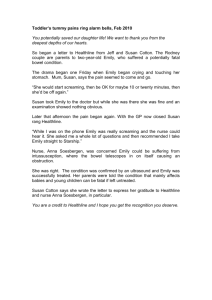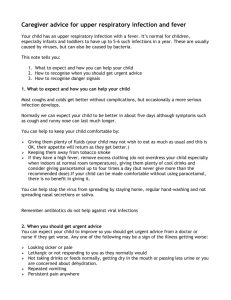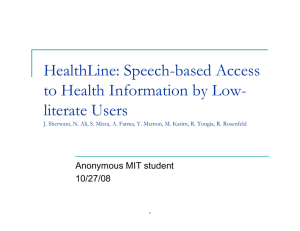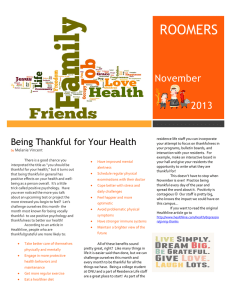Running head: APPLYING HONCODE PRINCIPLES: AN EVALUATION OF 1
advertisement
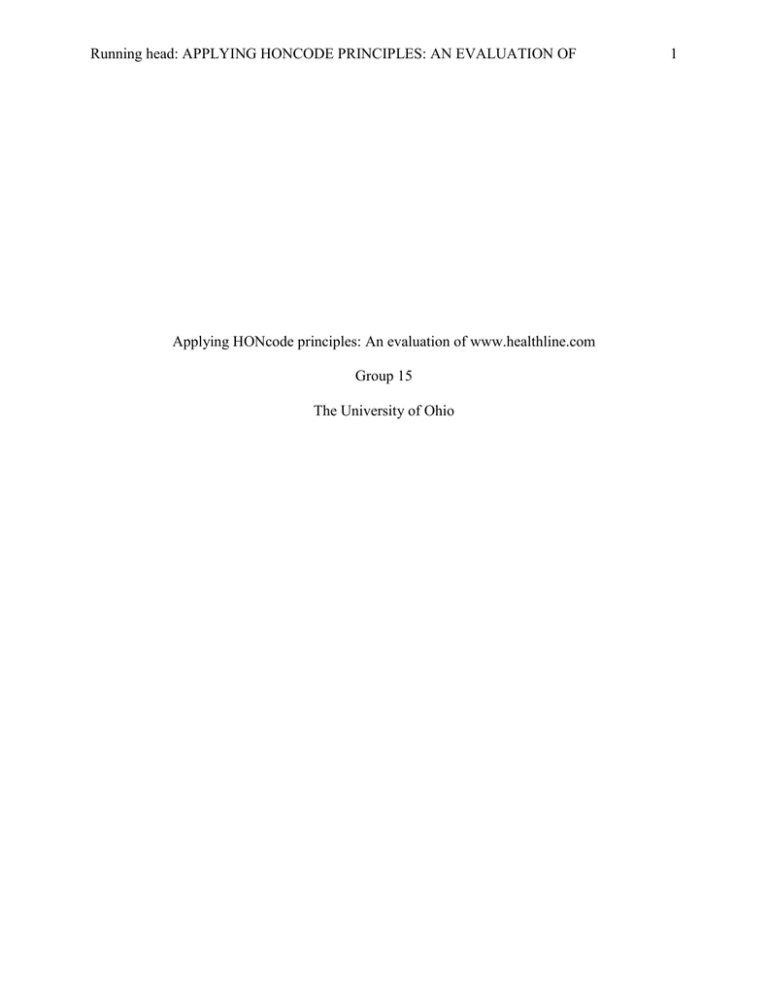
Running head: APPLYING HONCODE PRINCIPLES: AN EVALUATION OF Applying HONcode principles: An evaluation of www.healthline.com Group 15 The University of Ohio 1 APPLYING HONCODE PRINCIPLES: AN EVALUATION OF 2 Applying HONcode principles: An evaluation of www.healthline.com Health and medical information is plentiful on the internet. The use of the search engine Google and the term ‘health information’ returned over three million results. Some come from reputable sites such as the National Institute of Health; although the reliability of other sites is harder to determine. To this end, many groups and organizations have designed formal and informal evaluation guides for health information on the internet. The HONcode Health on the Net Foundation is a non-governmental organization, which promotes accurate and useful health information on the internet (HON, 2011). It was created in 1995 as an international organization to develop a set of standards for health information known as the HONcode (Boyer, Baujard, & Geissbuhler, 2011; HON, 2011). The HONcode has also been translated into 35 different languages and was selected in 2007 to be the official certifying body of French health websites by the French government (Boyer et al., 2011). By the close of 2010, over 7,400 websites earned the HONcode seal. Meeting the HONcode standards allows a website to display a seal of compliance that first appeared in 1996. Boyer et al., (2011) state that HON quickly moved to create a verification process, with each seal being linked to a unique HONcode certificate on the HON website. This allows HON to control the final verification of certification. Additionally, individuals can report to the HON any website that is felt to be in violation of the HONcode. HON staff investigates these reports within 14 days (Boyer et al., 2011). The HONcode addresses eight principles of ethical and quality information: authority, complementary, confidentiality, attribution, justifiability, transparency, financial disclosure, and advertising (HON, 2011, appendix 1). To receive the HONcode seal, a website must meet the APPLYING HONCODE PRINCIPLES: AN EVALUATION OF 3 standard for each of these principles (Boyer et al., 2011; HON, 2011). To evaluate the website Healthline.com, the HONcode was selected primarily due to its long history and its thorough assessment of a website as evidenced by the eight principles. Website for Evaluation The website, Healthline.com, is owned by Healthline Network, Inc. (HNI, 2011a). It is a general health website with various sections that allow you to seek information on diseases, conditions, medications, treatments, and health promoting activities. Additionally, Healthline.com allows a user to search for health care providers, including nurse practitioners and midwives, based on search parameters that include gender, language spoken, specialty, and practice location. Healthline.com was selected for evaluation for several reasons, the first being the HON does not currently certify the website. Secondly, Healthline.com is listed as one of the “Top 15 Best Health Websites” (ebizmba, 2011). It is reasonable to expect that, in the quest for information, health consumers would search out the best or most popular websites in an effort to receive accurate information. Evaluation Authoritative: The authoritative quality of health information websites describes the qualifications of the authors providing information. The HONcode qualifies the types of authors that should be utilized in providing information to consumers through health information websites. The HONcode states that any medical or health advice provided “will only be given by medically trained and qualified professionals unless a clear statement is made that a piece of advice offered is from a non-medically qualified individual or organization” (HON, 2011, para. 2). APPLYING HONCODE PRINCIPLES: AN EVALUATION OF 4 Furthermore, qualifications of authors, including specialties of medical doctors, providing advice must be plainly noted. Also, if the author is not a medically qualified professional, it must be clearly stated on the website or article (HON, 2011, para. 2). The Healthline.com editorial team consists of a group of editors and reviewers with various backgrounds. Seven of the team members have obtained liberal arts degrees with majors in writing or English. There is five medically trained staff, including three physicians, one registered nurse, and one pharmacist. Consumers can easily find background information pertaining to each editor and staff reviewer by accessing the link for Healthline.com staff on the website’s main page (HNI, 2011d). In assessing the Healthline.com site for how authoritative its information is, several articles were reviewed. Of these articles, all were written by one of the editorial staff members of Healthline.com. Most were then reviewed by a medical professional, with credentials clearly stated under the title of each article. However, in a couple of the articles reviewed, there were no credentials listed for the person reviewing the information provided. In fact, one article had no professional reviewing it. The consumer must therefore be cognizant of the fact that some articles may prove to be more credible than others, thus resulting in Healthline.com only partially satisfying the criteria required for HONcode certification. Complementarity: The principle of complementarity, according to the HONcode, states that information provided on a health information website should “support, not replace, the doctor-patient relationship” (HON, 2011, para. 3). Further, websites providing health information to consumers must provide a statement on their site clearly stating such. Websites must also include a description of the site’s mission, purpose, and intended audience (HON, 2011, para. 3). APPLYING HONCODE PRINCIPLES: AN EVALUATION OF 5 Healthline.com partially satisfies this component. It does have a clear statement regarding use of medical information obtained from the site. Under the “Terms of Use” for Healthline.com, the consumer can find the site’s complementarity statement: “content is not intended to be a substitute for professional medical advice, diagnosis, or treatment. Always seek the advice of your physician or other qualified health provider with any question you may have regarding a medical condition” (HNI, 2005, para. 1) The purpose of Healthline.com can be identified in the terms of use as well. It is listed as being for “informational purposes only” (HNI, 2005, para. 1). The intended audience includes healthcare consumers. What is not clearly identified within the site is the mission of healthline.com; therefore, Healthline.com only partially meets the requirements for HONcode certification. Privacy: The HONcode criteria for evaluation address the privacy practices of a website. HONcode specifies that websites must comply with or exceed the legal requirements of health information privacy in the country and state in which the web site originated. Healthline.com, based out of San Francisco, California, was recently evaluated utilizing the HONcode specifications. Similar to federal laws governing privacy in health care, California civil code, section 1798.91 states, "a business may not request medical information from an individual and use, share, or otherwise disclose that information for direct marketing purposes without explicitly disclosing that the information will be used for advertising purposes" (California, 2004). Additionally, that same law requires that a business obtain the individual's, or the legal representative thereof, consent prior to the request for medical information. Although APPLYING HONCODE PRINCIPLES: AN EVALUATION OF 6 Healthline.com does not directly state that it honors state and federal laws regarding health information, the website does appear compliant with applicable laws. Healthline.com does, however, acknowledge that there are certain circumstances in which information is collected anonymously by various advertisers from their site such as while registering a new account, updating profiles, and entering sweepstakes; however Healthline.com does state that a user will be notified prior to registration that their contact and demographic information may be shared with a third party agency (HNI, 2010b). As a security measure, Healthline.com does utilize their own servers to store information collected from their site and protects that data though additional security measures that are "industry recognized". Moreover, Healthline.com readily admits to employing third parties to gauge the effectiveness of the company's security measures on an irregular basis. Healthline further states that, "[the company] does not make a practice of de-identifying personal information on any kind of regular schedule" (HNI, 2010b, para. 3). The last component of the HONcode evaluation criteria for privacy involves tracking and sharing visitors' data--specifically the use of cookies. "A cookie is a very small file written to the hard drive of a computer whose user is surfing the internet" (McGonicle & Mastrian, 2009, p. 188). Healthline.com also admits to utilizing cookies and targeted advertising; however the website's privacy page, Healthline Networks ensures that information has been de-identified and aggregated before any information is shared with any third party organizations, potential advertisers, and research firms. The information gathered from Healthline.com is used to monitor movement on the web site and to personalize content and advertising (HNI, 2010b). Healthline.com does directly address the websites compliance with the Federal Children's Privacy Protection Act of 1998 stating that they "will never knowingly request personally APPLYING HONCODE PRINCIPLES: AN EVALUATION OF 7 identifiable information from any user under the age of 13 without parental consent" and that "personal information of members under the age of 13 will never be knowingly shared with third parties, regardless of the members stated preference" (HNI, 2010b, para. 17). Healthline.com does attempt to offset the heavy use of data mining tactics by informing the user of effective countermeasures of data collection by providing tips on how to block and delete cookies, disable web beacons, and opt out of online behavioral advertising and anonymous data collection. Transparency is lost in the privacy policy, however, as the user is later warned that the website will not divulge what information has been collected from the user (HNI, 2010b). The HONcode evaluation criterion for privacy does not disallow the utilization of cookies; however it does call for transparency regarding these practices. By denying full disclosure of data mining practice to individual inquiries, Healthline.com does plant a seed of distrust; however, their inclusion of actions that can be taken to block many of the aforementioned practices does allow Healthline.com to meet the HONcode standard for privacy. Attribution: The HONcode evaluation criteria addresses attribution as it relates to appropriately referencing health and medical content. According to the HONcode criteria, "[the website has] to clearly indicate the recognized, scientific or official sources of health information quoted in [the] articles" (HON, 2011, para. 4) and the reference cited must yield the information attributed to that source, preferably via a hypertext link (HON, 2011, para. 4). It would be beyond the scope of this paper to perform reference checks on all pages containing medical information on Healthline.com; however Healthline.com's ability to correctly attribute medical information to appropriate sources was evaluated utilizing the ten most common medical queries on WebMD as APPLYING HONCODE PRINCIPLES: AN EVALUATION OF 8 determined by the Pew Internet and American Life Project. The top ten most queried conditions in 2010 were: shingles, gallbladder, gout, hemorrhoids, lupus, skin problems, allergies, heart disease, diabetes and sleep disorders (Fox, 2011). According to the table in appendix 2, shingles, gallbladder (stones), gout, hemorrhoids, lupus, and skin problems (cold sores) are correctly referenced to appropriate sources; typically articles from scientific journals. For the heavily researched autoimmune disease lupus, Healthline.com only references two medical textbooks. Furthermore, none of the references contain hyperlinks to the original source as recommended by the HONcode. Additionally, allergies (hay fever), heart disease, diabetes, and sleep disorders (sleep apnea) have no sources attributed to their content. In each case, the content was written by editorial staff of Healthline.com and reviewed by a medical doctor with no specializations noted. Undisclosed sources and reviews by generalists place the credibility of Healthline.com into question as heart disease is the leading cause of death in the United States and nearly 26 million Americans suffer from diabetes (CDC, 2011). Since medical science is constantly evolving, HONcode also requires a date of creation and modification under the evaluation criteria for attribution. The criteria states, "all medical content must have a specific date of creation and date of last modification" (HON, 2011, para. 4). On the table in appendix 1, only gout, allergies (hay fever), heart disease, diabetes, and sleep disorders (apnea) specify a date of creation. Healthline.com does not have a date of modification listed for any of the ten queries performed. There is, however, a date of last review for shingles, gallbladder (stones), hemorrhoids, lupus, and skin problems (herpes labialis). The most recent date of review for gallbladder (stones) was conducted in July 2009. A further clustering of dates indicate that a systemic review of all pages took place in late 2008 through 2009 or that it is in APPLYING HONCODE PRINCIPLES: AN EVALUATION OF 9 fact, the original date of posting. A date of review was absent for half of the queries including heart disease and diabetes. Heart disease, diabetes, and their associated treatments are continuously researched extensively and are subject to cutting edge technology; therefore the occlusion of a content review date further decreases the credibility of the site. Furthermore, the HONcode evaluation criteria for attribution states that, "dates of modification must be present on pages containing privacy policies, legal information, author descriptions, the mission statement, and statements regarding the website's intended audience" (HON, 2011, para 4). Healthline.com does include dates of modification on all of the required administrative pages except for the page describing the staff of Healthline.com. Although Healthline.com generally met the HONcode requirements for attribution on the reviewed administrative pages, it did not sufficiently reference or update the medical content to meet HONcode guidelines. Furthermore, given the extensive data mining techniques employed by Healthline.com and the inconsistently referenced, potentially outdated medical information that it supplies, Healthline.com appears to value advertising over education. The end result is that Healthline.com only partially meets the required criteria for HONcode certification. Justification: According to the HONcode, “All information about the benefits or performance of any treatment (medical and/or surgical), commercial product or service are considered as claims. All claims have to be backed up with scientific evidence (medical journals, reports or others)” (HON, 2011, para. 1). After a random sampling of topics of the Healthline.com website, it was found to be inconsistent with backing up its claim. According to the editorial policy page: APPLYING HONCODE PRINCIPLES: AN EVALUATION OF 10 All original content is produced by highly skilled writers or experienced health professionals who are adept at researching a variety of topics and delivering concise, accurate, and engaging information in an easy to understand format. When applicable, articles are reviewed by a health professional--a doctor, nurse, dietician, nutritionist, etc.-to ensure the information is accurate. (HNI, 2011b, para. 1) Although medical professionals, who generally have their credentials listed, have reviewed the articles, the original content of most articles do not cite sources such as medical journals or scientific research. Additionally, the following disclaimer was also found on the website: "The content is not intended to be a substitute for professional medical advice, diagnosis, or treatment. Always seek the advice of your physician or other qualified health provider with any question you may have regarding a medical condition" (HNI, 2005, para. 2). Also noted, most of the articles had a small icon at the bottom, displaying the site from where the article was licensed. It is evident that most of the articles on Healthline.com are not written by Healthline.com staff, but rather by contracted sources, such as ADAM Health Illustrated Encyclopedia. Thus, in order to authenticate the overall reliability of Healthline.com, it would be necessary to validate every contracted source as well (a time-consuming process beyond the scope of this paper). Moreover, the criteria for justification by the HONcode includes that “all brand names have to be identified (with ® for example)” (HON, 2011, para 2). Healthline.com does distinguish generic names from brand names, but it does not utilize the Registered Trademark symbol “®” to do so. Generally, the brand names are capitalized and in parentheses and the generic names are not. This might be confusing to consumers who have not had exposure to medical terminologies or even a basic knowledge about prescription drugs or herbal remedies. APPLYING HONCODE PRINCIPLES: AN EVALUATION OF 11 Healthline does, however, make the following disclaimer in regards to its description of the medicine, such as acetaminophen: “This medicine may be used for other purposes; ask your health care provider or pharmacist if you have questions” (HNI, 2009b, para. 2). Further criteria listed for utilization in a justification evaluation on the HONcode website indicates that a website “must include alternative therapies or products (including generics)” (HON, 2011, para. 3). Alternative therapies are listed and include therapies such as acupuncture and relaxation therapy. The site also lists herbal therapies, however very seldom do they cite references for their treatments (1 out of approximately every 10). Most drugs have both the generic and brand(s) name available along with the disease specific to which it treats. Based on all of the qualitative criteria listed, Healthline.com receives only a moderate score for compliance; leaving reason to believe that there are better choices for health information available to the general public elsewhere on the internet. Website contact details: According to principle 6 of the HONcode, “the website must be operational and the information must be accessible and clearly presented” (HON, 2011, para. 1). Although it was fairly easy to maneuver the website, it did tend to contain many advertisements that could potentially distract readers from easily obtaining the information they were searching for. There were several modes used on the website to enhance learning, such as 3D pictures, videos, hyperlinks to medical definitions, in addition to the regular text. This blended learning method enhances users’ learning activities (McGonigle & Mastrian, 2009, Chapter 22). After browsing several links, it was noted that almost all the links worked properly. The site was specifically designed to allow users to search for diseases, symptoms, treatments/drugs, and also obtain the contact information for local practitioners specialized to APPLYING HONCODE PRINCIPLES: AN EVALUATION OF 12 treat the specified ailment. As previously mentioned, Healthline.com utilizes content from several licensed websites that include: ADAM, GALE Cengage Learning, and Gold Standard; raising the question as to whether these are paid sources, or legitimately the best resources available on the World Wide Web. Unfortunately, that question is later answered on the “About Healthline” page, where it does state there is a relationship between Healthline.com and these licensed sites which allow them to, “simultaneously enrich their content, increase distribution and improve monetization with no additional effort on their part” (HNI, 2011). Also listed in principle 6 of the HONcode is the necessity of editor contact information, such as an email address for visitors who would like to have more details or support and that “this contact must be easy to access from anywhere on the site” (HON, 2011, para. 2). At the bottom of every page under company information, there was a link to the “contact us” page. Under the contact page for the website there are specific email addresses listed for advertising, business development and licensing, and career opportunities, however, there is not a specific email address listed for the editor. You are able to email the site with questions on a general form that contains the following disclaimer: We cannot give medical or drug advice via email. If you think you may have a medical emergency, call your doctor or 911 immediately. Always seek the advice of a qualified healthcare provider with any questions you may have regarding a medical condition. (HNI, 2011e, para. 2) This clearly leaves the impression that the Healthline.com website does not allow for direct questions from consumers regarding health issues; thus, forcing them to turn to alternate sources. Lastly, the final requirement in the HONcode principle 6 states, "You must give an individual and prompt answer to any website visitors' enquiries" (HON, 2011, para. 3). Two APPLYING HONCODE PRINCIPLES: AN EVALUATION OF 13 attempts were made to email the website, from separate email addresses, on different occasions, with no response from Healthline.com. This is in direct violation of the HONcode, thus overall, Healthline.com did not meet the criteria for Website contact details. Financial Disclosure: The HONcode evaluation criteria address financial disclosure. While funding sources were not prominently displayed, the website does list the HNI investors. Little information is provided about the nature of the relationship between Healthline.com and the investors. An additional requirement of the financial disclosure principle is for a website to disclose any potential conflict of interest. Neither admissions nor denials of any conflicts of interest were noted. The editorial policy of Healthline Networks, Inc., mentions a conflict of interest policy; however, the reviewing authority was unsuccessful in locating the policy. In general, the Healthline.com website does not meet the HONcode’s principle of financial disclosure. Advertising Policy: The HONcode evaluation criteria addresses advertisement as it relates to advertising, external links, and editorials. The HNI’s editorial policy (2011b) is to provide content based upon relevance, clinical significance, and editorial integrity. The HNI’s editorial policy is to label outside content as “Sponsored”, “From Our Sponsor”, “Sponsored Resource”, or “Advertisement”. Additional policies further address outside content. When Healthline.com licenses to use third-party content, the content management team evaluates the third-party’s editorial policies for parity with the HNI’s policies (HNI, 2011b). It is expected that the third-party adheres to these policies. Additionally, third-party entities are required to have their content “medically reviewed” annually. APPLYING HONCODE PRINCIPLES: AN EVALUATION OF 14 The HNI’s sponsors have usually paid for the privilege to associate themselves with Healthline.com. HNI does not provide paid inclusion; therefore, sponsors are not able to specify where they will appear as the result of a search conducted through Healthline.com’s search feature. HNI’s advertising and promotion policy (2010) states that Healthline.com has sole discretion to determine the types of advertising displayed on the website. Healthline.com will reject any advertising they feel is inaccurate, of an unacceptable topic for the website, is illegal or otherwise deemed inappropriate. The advertising policy also requires a clear distinction between Healthline.com content and that of the advertisement through obvious labeling and clear identification of the advertiser. A feature offered to advertisers by Healthline.com is a contextual ad targeting technology that allows an advertiser to reach condition specific information seekers (HNI, 2011). This allows for audience targeting by advertisers. An example of this appears when conducting a search for ‘AIDS’, advertisements for Reyataz®, a medication used to treat HIV/AIDS are displayed. A search for ‘ADHD’ results in advertising for Intuniv®, a medication used to treat ADHD (Jones and Bartlett, 2011). There are at least two advertisement banners per webpage. The banners are labeled as an advertisement; however, the type is small, especially on the smaller boxed advertisement generally located on the right-hand side of the page. While the reviewing authority is internet savvy and was purposefully investigating the advertisements, the reviewing authority wonders if an 85-year-old grandmother would be able to read the word “advertisement” associated with the banner or if she would even be able to decipher the banner as being an advertisement and not part of the page’s content. APPLYING HONCODE PRINCIPLES: AN EVALUATION OF 15 The targeted advertising mentioned earlier also leads to the ambiguity of the advertising. Reyataz ® is used to treat AIDS; therefore it fits into the content of the page. When a search is conducted for ‘animal bite wound’, the advertisement for the retail giant Marshalls appears stand out more as it has little to do with the topic queried. The reviewing authority found sponsored content resulting from searches conducted on the Healthline.com website even more subtly labeled than advertising. The sponsored links are listed at the top of the where users of popular search engines such as Google are used to finding the most popular or appropriate results of a search. The sponsored links are on a light blue background with “sponsored links” in light grey in the top right-hand corner with the links themselves lined up on the left-hand side. When ‘animal bite wound’ is queried, the colored banner is noticeable because the remaining results are on a white background. When ‘AIDS’ is searched, the sponsored link banner is less noticeable because other results are clustered on light gray and a darker light blue areas. While HNI follows their policies with regard to labeling advertisements and third-party content, the reviewing authority feels that HNI has not met the required criteria of such additions being listed as “clearly and unambiguously identified as such” when you consider the average health consumer (HNI, 2010a, para. 5). Conclusion Utilizing the World Wide Web to search for health care information has been growing in popularity since the invention of the internet. Unfortunately, not all of the medical information that is found can be deemed as accurate. It has been previously determined that websites containing accurate and up to date information bear the compliancy seal of the Health on the Net Foundation. In the evaluation of the Healthline.com website, it was found by this reviewing APPLYING HONCODE PRINCIPLES: AN EVALUATION OF authority to have too many inconsistencies while only partially satisfying the requirements for HONcode certification. Since HONcode requires all elements be fully met, Healthline.com cannot receive an acceptable recommendation from this authority. 16 APPLYING HONCODE PRINCIPLES: AN EVALUATION OF 17 References Boyer, C., Baujard, V., & Geissbuhler, A. (2011). Evolution of health web certification through the HONcode experience. Studies in Health Technology and Informatics, 169, 53-57. DOI: 10.3233/978-1-60750-806-9-53 California Civil Code 1798.91, (2004). Retrieved from http://chili.ohii.ca.gov/content/civil-code179891-2004 Centers for Disease Control and Prevention. (2011, January 26). Get the facts on diabetes. Received from http://www.cdc.gov/features/diabetesfactsheet/ Centers for Disease Control and Prevention. (2011, January 31). CDC features: February is American heart month. Received from http://www.cdc.gov/features/heartmonth/ ebizMBA Inc., (2011). Retrieved from http://www.ebizmba.com/articles/health-websites Federal Children’s Privacy Protection Act, 15 U.S.C. §§ 6501–6506(1998). Retrieved from http://www.ftc.gov/ogc/coppa1.htm Fox, S. (2011, February 1). Health Topics. Pew Internet & American Life Project. Received from http://www.pewinternet.org/Reports/2011/HealthTopics/Part3.aspx?view=all Health of the Net Foundation. (2011). The HON code of conduct for medical and health web sites (HONcode). Retrieved from http://www.hon.ch/HONcode/Conduct.html Healthline Networks, Inc. (2005). Terms of Use. Retrieved from www.healthline.com/termsofuse.jsp Healthline Networks, Inc. (2009). Information about healthline sponsors. Retrieved from http://www.healthline.com/sponsor_information.jsp Healthline Networks, Inc. (2009b). Acetaminophen oral tablet. Retrieved from APPLYING HONCODE PRINCIPLES: AN EVALUATION OF 18 www.healthline.com/goldcontent/acetaminophen Healthline Networks, Inc. (2010a). Healthline advertising & promotions policy. Retrieved from http://www.healthline.com/advertising_policy.jsp Healthline Networks, Inc. (2010b). Privacy Policy. Retrieved from http://www.healthline.com/privacypolicy.jsp Healthline Networks, Inc. (2011a). About Healthline. Retrieved from www.healthline.com/aboutus.jsp Healthline Networks, Inc. (2011b). Editorial policy. Retrieved from www.healthline.com/editorial_policy.jsp Healthline Networks, Inc. (2011c). Healthline.com. Retrieved from www.healthline.com Healthline Networks, Inc. (2011d). The Healthline Editorial Team. Retrieved from http://www.healthline.com/who-we-are.jsp Healthline Networks, Inc. (2011e). Customer support and feedback. Retrieved from www.healthline.com/yourfeedback.jsp HIPPA Privacy Rule, 45 C.F.R § 164.508(a)(3), (2002). Retrieved from http://www.access.gpo.gov/nara/cfr/waisidx_02/45cfr164_02.html Jones & Bartlett Learning (2011). Nurse’s drug handbook (10th ed., pp. 496-497, 1142). Sudbury: Jones and Bartlett. McGonigle, D. &Mastrian, K. (2009). Nursing informatics and the foundation of knowledge. Sudbury: Jones and Bartlett. WebMD, (2011). WebMD.com. Retrieved from www.webmd.com. APPLYING HONCODE PRINCIPLES: AN EVALUATION OF Appendix 1 The HONcode: Principles Principle 1 Authority Give qualifications of authors Principle 2 Complementarity Information to support, not replace Principle 3 Confidentiality Respect the privacy of site users Principle 4 Attribution Cite the sources and dates of medical information Principle 5 Justifiability Justification of claims / balanced and objective claims Principle 6 Transparency Accessibility, provide valid contact details Principle 7 Financial disclosure Provide details of funding Principle 8 Advertising Clearly distinguish advertising from editorial content 19 APPLYING HONCODE PRINCIPLES: AN EVALUATION OF 20 Appendix 2 Table 1 Inclusion of Appropriate Source Referenced, Creation Date, and Review Date by Healthline.com for the Top Ten Medical Queries Appropriate Source Medical Queries Referenced Creation Date Review Date Shingles Yes, 5 scientific None 6/10/09 journal articles Gallbladdera Yes, 2 texts, 1 scientific journal article None 7/6/09 Gout Yes, 1 text, 8 scientific journal articles 1/1/11 None Hemorrhoids Yes, 3 texts, 1 medical position statement None 5/15/09 Lupus Yes, 2 textbooks None 2/3/09 Skin Problemsb Yes, 2 scientific journal articles None 5/21/08 Allergiesc No references listed 8/25/10 None Heart Disease No references listed 9/15/10 and 10/15/10 None Diabetes No references listed 8/25/10 None Sleep Disordersd No references listed 8/25/10 None Note. Healthline.com uses the term “Last reviewed” instead of the HONcode wording “Date of last modification” (HONcode, 2011). Top ten medical queries adapted from “Health Topics,” by Fox. S., 2011, Pew Internet & American Life Project. aSearch term = gallstones. bSearch term = herpes labialis. cSearch term = hay fever. dSearch term = sleep apnea.
